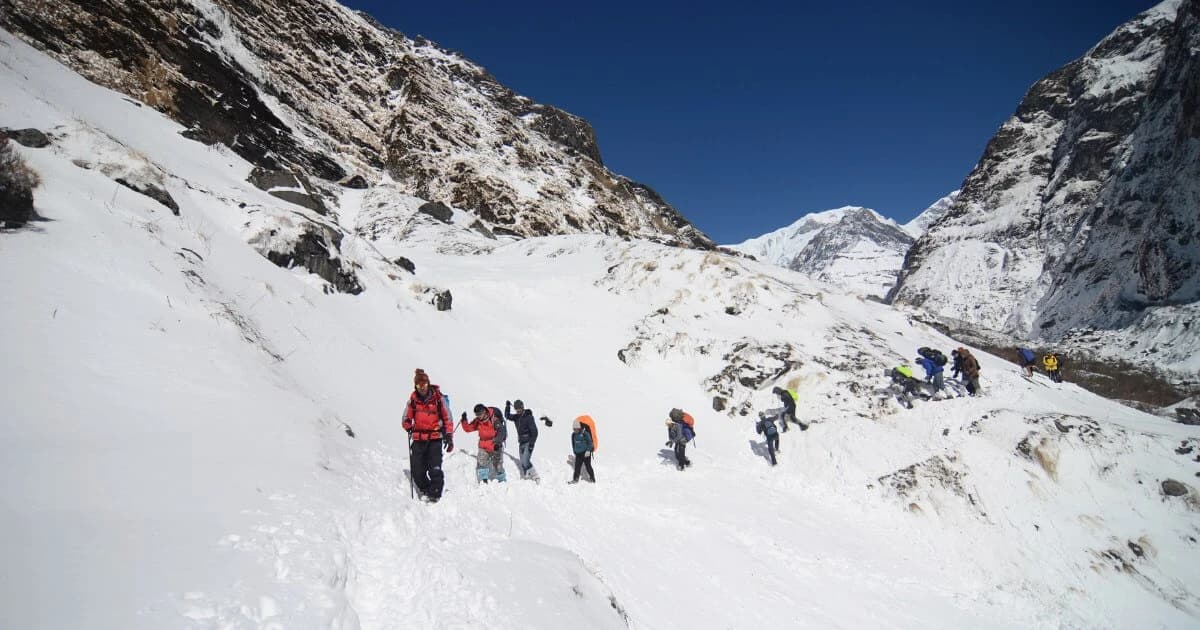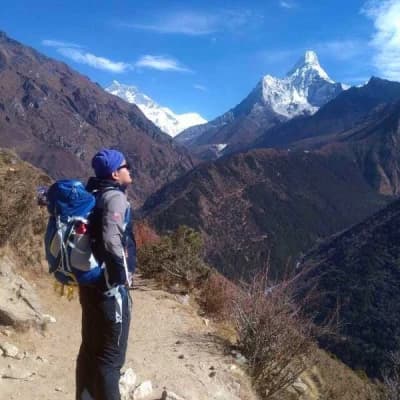Thinking about tackling a high-altitude trek in Nepal? Whether you're dreaming of Everest Base Camp, the Annapurna Circuit, or the Manaslu Circuit, these treks are absolutely breathtaking—but they’re no walk in the park! You’ll need to prepare for challenges like altitude sickness, unpredictable weather, and sheer physical exhaustion. But don’t worry—I’ve got you covered. Here are some must-know tips for high altitude treks in Nepal to make your trek safe, smooth, and enjoyable.
As an experienced trekker and travel expert specializing in Nepal’s high-altitude adventures, I’ll share practical, research-backed insights to ensure you have the best experience.
1. Get in Shape Before You Go
High-altitude trekking isn’t something you can just wake up and do. You need to build endurance, strength, and stamina. Experts, including professional mountaineers, recommend training at least 2-3 months in advance by:
- Doing cardio workouts like running, cycling, or swimming to boost lung capacity.
- Going on long hikes with a backpack to get used to carrying weight.
- Strengthening your legs with squats and lunges to handle steep trails.
- Adding yoga or stretching to improve flexibility and prevent injuries.
2. Acclimatization is Everything
Altitude sickness can be dangerous if you don’t give your body time to adjust. The World Health Organization (WHO) and the Himalayan Rescue Association (HRA) emphasize the importance of acclimatization. Here’s how to do it properly:
- Take it slow—don’t ascend more than 500m per day once you’re above 3,000m.
- Plan rest days to let your body adjust and adapt.
- Follow the "climb high, sleep low" rule to minimize risks.
- Pay attention to your body—if you feel off, don’t push through. Descend if necessary!
3. Stay Hydrated and Eat Well
Your body works harder at high altitudes, so proper nutrition and hydration are essential. According to research by altitude medicine specialists:
- Drink at least 3-4 liters of water daily (yes, that much!) to prevent dehydration.
- Avoid alcohol and too much caffeine—they contribute to dehydration and altitude sickness.
- Load up on carbs like rice, pasta, and potatoes for sustained energy.
- Include protein-rich foods like eggs, lentils, and nuts to support muscle recovery.
4. Pack Smart—Less is More!
Carrying the right gear can make or break your trek. Based on our recommendations as your packing list should include:
- Layered clothing (base layer, warm layer, waterproof outer layer) for varying temperatures.
- Sturdy, well-worn trekking boots to prevent blisters and provide ankle support.
- A sleeping bag rated for -10°C to -20°C to stay warm in cold teahouses.
- UV-protection sunglasses and high-SPF sunscreen to protect against harsh sun exposure.
- Trekking poles to reduce strain on your knees.
- A first-aid kit with altitude sickness medication and essential supplies.
5. Hire a Guide and Porter
Even if you're an experienced trekker, hiring a guide can enhance your journey. A professional guide provides:
- Expert navigation and safety measures.
- Local insights into culture, wildlife, and history.
- Immediate assistance in case of altitude sickness or emergencies.
- Hiring a porter also lightens your load, making the trek more enjoyable.
Choose a reputable trekking agency like Tidy Himalaya (us) that treats its staff fairly and follows responsible tourism practices.
6. Know the Signs of Altitude Sickness
Altitude sickness can be life-threatening if ignored. According to the International Society for Mountain Medicine (ISMM), watch out for:
- Headaches, nausea, and dizziness—early warning signs.
- Loss of appetite and trouble sleeping—common symptoms at higher elevations.
- Shortness of breath even when resting—requires immediate attention.
To prevent it:
- Acclimatize properly and listen to your body.
- Consider taking Diamox (after consulting a doctor) to help with adaptation.
- If symptoms get worse, descend immediately—never ignore altitude sickness!
7. Pick the Right Season to Trek
Timing your trek well can make a huge difference. Based on weather data and expert recommendations:
- Spring (March-May): Ideal for trekking with mild weather and blooming rhododendrons.
- Autumn (September-November): Offers stable weather and stunning mountain views.
- Avoid monsoon season (June-August) due to heavy rain and landslides.
- Winter (December-February) is extremely cold, making high passes difficult to cross.
8. Respect the Culture and Nature
Trekking in Nepal isn’t just about the mountains—it’s also about experiencing the rich culture of the Himalayas. Follow these ethical trekking practices:
- Dress modestly and be mindful of local customs and traditions.
- Take all your trash with you—leave no trace behind.
- Use refillable water bottles and avoid plastic waste.
- Always ask before taking photos of locals out of respect for their privacy.
Popular Treks at High Altitudes in Nepal
Several of the most popular high-altitude treks in the world originate in Nepal:
Everest Base Camp (EBC) Trek: At 17,598 feet (5,364 meters), EBC provides breathtaking views of Mount Everest and the surrounding peaks.
Annapurna Circuit Trek: This hike offers a variety of scenery, from lush subtropical woods to alpine landscapes, and reaches an altitude of 17,769 feet (5,416 meters) at Thorong La Pass.
Manaslu Circuit Trek: This journey, which reaches 16,752 feet (5,115 meters) at Larkya La Pass, is well-known for its isolated paths and rich cultural heritage.
Final Thoughts
Trekking in Nepal’s high-altitude regions is a once-in-a-lifetime adventure, but preparation is key. Backed by expert advice and research, these tips will help you trek safely and enjoy the journey. Train well, take it slow, stay hydrated, and always put safety first.
With the right mindset and preparation, you’ll have an unforgettable experience in the Himalayas.
More About on How to Prepare for High Altitude Treks in Nepal
How Should a High Altitude Trekker Handle Altitude Sickness?
The best way to avoid altitude sickness is to gradually acclimate to higher elevations. This can be accomplished by allowing your body to acclimate to a higher altitude over several days, commencing your walk at a lower level. Drinking lots of water and staying hydrated is also essential to help your body adjust to reduced oxygen levels at high elevations. Since alcohol and tobacco can dehydrate the body and make it more difficult for the body to adjust to the altitude, avoiding them can also help prevent altitude sickness. Using drugs like Diamox can also lessen the risk of altitude sickness.
What Are The Symptoms Of High Altitude Sickness?
Altitude sickness frequently manifests as headache, nausea, exhaustion, lightheadedness, insomnia, and appetite loss. These symptoms may worsen with altitude and may result in more severe cases of altitude sickness, such as cerebral edema and high-altitude pulmonary edema (HAPE and HACE). Breathing difficulties, pressure in the chest, disorientation, and lack of coordination are some of these symptoms.
What Are The Risks of High Altitude Trekking?
Trekking at high altitudes can be gratifying and hard, but there are a number of risks involved. One major concern is altitude sickness, which occurs when the body cannot adapt to the lower oxygen levels at high altitudes. Symptoms include headache, nausea, exhaustion, and shortness of breath. Another risk is hypothermia because at high elevations, where temperatures can drop rapidly, the body loses heat more quickly than it can generate it. There's also a chance of frostbite, especially on the fingers, toes, nose, and ears. Because of the steep and uneven terrain's potential for difficulty in navigation, falls are another risk. It's critical to have an emergency plan, to acclimate appropriately, and to be well-prepared.
What kind of training is suggested for peak Expeditions in Nepal?
Altitude simulation, strength training, endurance training, and cardiovascular exercise are a few of the suggested training regimens.
How important is mental preparation for peak expeditions in Nepal?
Because mental preparation aids in stress management, positive thinking, and successful visualization, it is equally as important as physical fitness.


.webp&w=1200&q=75&dpl=dpl_2PwU5ZDv8uoJ3KrzEVbz8N547HgX)
.webp&w=1200&q=75&dpl=dpl_2PwU5ZDv8uoJ3KrzEVbz8N547HgX)
.webp&w=1200&q=75&dpl=dpl_2PwU5ZDv8uoJ3KrzEVbz8N547HgX)
.webp&w=1200&q=75&dpl=dpl_2PwU5ZDv8uoJ3KrzEVbz8N547HgX)
.webp&w=1200&q=75&dpl=dpl_2PwU5ZDv8uoJ3KrzEVbz8N547HgX)